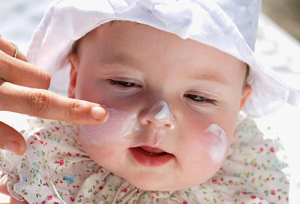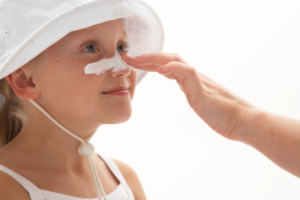Sunscreen
- Keep babies younger than 6 months out of direct sunlight. Find shade under a tree, umbrella, or the stroller canopy.
What Causes Sunburn?
Sunburn is caused by a type of ultraviolet (UV) light known as UVB, which can lead to skin cancer.
While UVB is still responsible for much of the skin damage caused by sunlight, especially sunburn, another ultraviolet light — UVA — may be an important factor in other types of sun damage.
The role of sunscreens is to absorb, reflect or scatter damaging UV rays before they have a chance to interact with the skin. Most sunscreens do a good job blocking UVB but fewer filter UVA. When protecting your skin, you need a product to block both UVA and UVB rays.
Skin Types
 According to the American
According to the American  Academy of Dermatology (AAD), knowing your skin type is important when choosing a sunscreen that will work best for you. There are six primary skin types.
Academy of Dermatology (AAD), knowing your skin type is important when choosing a sunscreen that will work best for you. There are six primary skin types.
- Redheads with blue or gray eyes generally have Type 1 skin, which burns and freckles but never tans. AAD recommends Type 1-people use a sunscreen with the highest SPF rating, as should all children.
- Type 2 skin — light blondes with blue or green eyes — eventually develops a tan but always burns after 20-30 minutes in the sun. Sunscreen with a high SPF (45) is recommended.
- People with Type 3 skin usually have dark blond or light brown hair and blue, green or brown eyes. They can develop a dark tan but will burn some, so they should begin with a high SPF, at least 30.
- People with Type 4 skin normally have naturally dark complexions, brown hair and eyes, and always tan dark brown. Even so, they can burn and should use at least an SPF 15 sunscreen.
- With Middle Eastern or Latin American ancestry, Type 5 skin rarely burns but should use a light sunscreen of SPF 4.
- Type 6, with black hair and dark skin usually never burns, but play it safe and use a sunscreen of SPF 4.
- SPF’s available can vary from <10, 15, 30, 45, 50, 55, 70, 75, 100.
How to Pick Sunscreen
- Use a sunscreen that says “broad-spectrum” on the label – that means it will screen out both UVB and UVA rays.
- Look for the new UVA “star” rating system on the label.
- One star is low UVA protection.
- Two stars is medium protection.
- Three stars is high protection.
- Four stars is the highest UVA protection available in an over-the-counter sunscreen product.
For sensitive areas of the body, such as the nose, cheeks, tops of the ears, and the shoulders, choose a sunscreen or sun block with zinc oxide or titanium dioxide. While these products usually stay visible on the skin even after you rub them in, some now come in fun colors that kids enjoy.
How to Apply Sunscreen
- It is very important to apply sunscreen 15 to 30 minutes before going outdoors to give time for the sunscreen to bind and absorb into to the skin.
- Use enough sunscreen to cover all exposed areas, especially the face, nose, ears, feet, and hands and even the backs of the knees. Rub it in well.
- Use sunscreen any time you or your child might sunburn. Remember that you can get sunburn even on cloudy days. Also, UV rays can bounce back from water, sand, snow, and concrete so make sure you’re protected.
- Reapply sunscreen every 2 hours. Sunscreen wears off after swimming, sweating, or just from soaking into the skin.
Diana Eisner, M.D., F.A.A.P.
